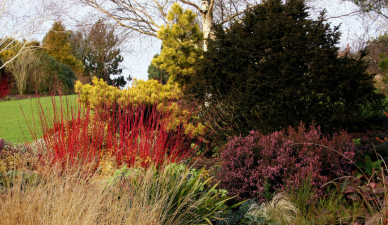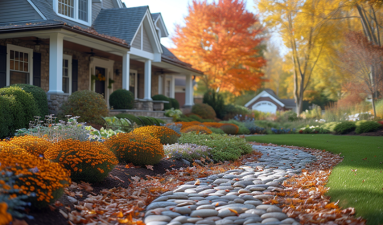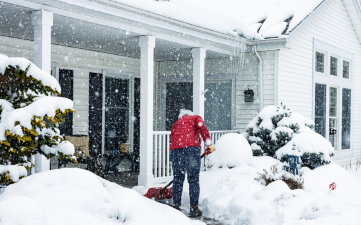Fall & Winter Garden Tips: How to Keep Your Yard Alive
A yard is not only a place to stay but also a place of spiritual refuge. In a fast-paced world, a personal space of solace, where you can watch flowers bloom and fall and listen to the wind through the bamboo forest, can quietly dissipate fatigue. Autumn is a season filled with poetry and philosophical reflection. Its rich colors and profound artistic conception invite us to a contemplative journey about nature, life, and time.
How should we decorate our autumn yard to both satisfy our visual sense and touch our soul?

- Plants are the soul of the yard.
A yard without plants is like a garden without a heartbeat. Choose low-care, vibrant plants to create a yard that offers a seasonal beauty, enjoyed every day.
Recommended low-maintenance plants:
Spring: Hydrangeas, roses, and bluebells fill the yard with fragrance when in bloom.
Summer: Mint, rosemary, and jasmine, whose refreshing fragrance dispels the heat.
Autumn: Chrysanthemums, osmanthus, and maple trees, whose warm and soothing colors are a welcome relief. Winter: Pine, cypress, and wintersweet: their toughness radiates vitality.
Tips: Planting at varying heights creates a sense of depth in the yard. Place a few pots of succulents in the corners; when sunlight filters through the leaves, even the shadows are soft.
- Flowing light and shadow bring the yard to life.
Light is the magician of the yard, and shadows its paintings. Cleverly utilizing light and shadow can create a yard with varying aesthetics at different times.
- Natural Lighting:
Morning sunlight is perfect for relaxing on a rattan chair, brewing a cup of tea, and watching the dewdrops glisten.
Afternoon, with its dappled shadows, is the perfect time to hang a string of wind chimes, letting the gentle sound of the breeze lull you to sleep.
- Lighting Design:
Warm yellow string lights: Wrapped around a fence or tree branches, they resemble twinkling fireflies at night.
Solar ground lights: Placed along paths, they save energy and add a sense of security.
- Creative Gardening: Expressing Your Lifestyle
The autumn yard is also a stage for showcasing your personal approach to life.
Through creative gardening, you can express your love and pursuit of life. For example, try planting some autumn-specific flowers, such as chrysanthemums and ornamental grasses. These are not only colorful but also emit a subtle fragrance, adding a touch of poetic charm to your yard.
Also, you can create gardening with discarded items, such as using old tires to make flower pots or bamboo fences to build flower stands. Such arrangements are both environmentally friendly and creative, showcasing the owner's wisdom and aesthetic taste.
- Incorporate cultural elements to enhance the meaning
For example, hang plaques with poems or display culturally significant ornaments, such as ceramic vases and stone carvings.
These elements not only enhance the yard's beauty but also subtly convey the owner's cultural heritage and aesthetic pursuits.
Living in such an environment undoubtedly nourishes and inspires the soul.
An autumn yard is a place filled with poetry and philosophical reflection.
By respecting nature, creating tranquil spaces, employing creative gardening, light and shadow art, and incorporating cultural elements, we can transform our yard into not only a beautiful landscape but also a sanctuary for spiritual peace and enlightenment.

Key Tips for Autumn Flower Care
- Avoid Waterlogging
Autumn is a critical period for growth and development after spring. Excessive watering can cause waterlogging. Waterlogging in flower pots is also harmful to plant roots, so a solution is needed. Place some leaves at the bottom of the pot; these leaves will form leaf mold over time. This allows water to quickly penetrate even if water accumulates, giving plant roots room to breathe.
- Adjust the pH
Some plants prefer acidic soil, but many people struggle with this. It's actually quite simple. Dilute some vinegar with water and add it to the soil to make it acidic, eliminating the need for specialized acidic soil.
Adding rice husk charcoal to the soil can slow mold growth and reduce the likelihood of bacterial growth. This method is suitable for plants grown in the south, where the air is humid and insect-infested, making it prone to bacterial growth, disease, and pests. Keeping the soil dry can reduce mold.
- Appropriate Lighting
Some plants prefer sunlight, while others don't, so it's impossible to meet the sunlight requirements of all plants. Plants that can't receive direct sunlight, such as Clivia, can be placed in a shaded area, while plants that prefer sunlight can be placed in direct sunlight.
Some plants don't require a lot of sunlight, so they can be grown in a dark room or out of direct sunlight. However, remember to ensure adequate ventilation; most plants require ventilation.
- Timely Pruning
Autumn is a critical time for pruning plants, but be mindful of your pruning technique. Insufficient pruning will affect flowering and leafing, while excessive pruning will slow growth. Pruning methods are described using several plant examples.
For example, crabapple blossoms should be pruned after they have finished blooming, removing any dead branches. This promotes a balanced nutritional balance. With the right pruning techniques, flowers can bloom even in winter.
Some plants need to be pruned during their dormant period, such as roses, which should be pruned during their dormant period. Pruning targets unhealthy branches and leaves, and roses should be pruned after they become sick. Pruning helps them bloom, so that they can bloom fully.


